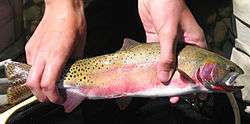Rio Grande cutthroat trout
| Rio Grande cutthroat trout | |
|---|---|
 | |
| Rio Grande cutthroat trout from the Conejos watershed in southern Colorado | |
| Scientific classification | |
| Kingdom: | Animalia |
| Phylum: | Chordata |
| Class: | Actinopterygii |
| Order: | Salmoniformes |
| Family: | Salmonidae |
| Genus: | Oncorhynchus |
| Species: | O. clarki |
| Subspecies: | O. c. virginalis |
| Trinomial name | |
| Oncorhynchus clarki virginalis (C. F. Girard, 1856) | |
The Rio Grande cutthroat trout (Oncorhynchus clarki virginalis), a member of the family Salmonidae, is found in northern New Mexico and southern Colorado in tributaries of the Rio Grande.,[1][2]
It is one of 14 subspecies of cutthroat trout native to the western United States, and is the state fish of New Mexico. Cutthroat trout were the first New World trout encountered by Europeans when in 1541, Spanish explorer Francisco de Coronado recorded seeing trout in the Pecos River near Santa Fe, New Mexico. These were most likely Rio Grande cutthroat trout (O. c. virginalis)[3]
Life history
Rio Grande cutthroat trout typically spawn between mid-May and mid-June. Males are sexually mature at age two; females mature at age three. They live an average of five years, but in rare cases, may survive into their teens. Rio Grande cutthroat feed opportunistically on aquatic insects and terrestrial insects that fall into the water.
Rio Grande cutthroat trout have irregular shaped spots that are concentrated behind the dorsal fin, smaller less numerous spots located primarily above the lateral line anterior to the dorsal fin, and basibranchial teeth that are minute or absent. Rio Grande cutthroat trout are light rose to red-orange on the sides and pink or yellow-orange on the belly.[4]
Conservation status
Rio Grande cutthroat have the distinction of being the southern most subspecies of cutthroat trout. However due to the loss of populations across their native range and reports of Rio Grande cutthroat in Mexico and Texas, it is unclear how far south this trout once occurred. The Mexican reports have been all but dismissed, but Garrett and Matlock (1991) provided evidence indicating that Rio Grande cutthroat were likely native to Texas. Today the southern most known populations are found on the eastern flanks of the Gila Mountains in Southern New Mexico.[5]
Rio Grande cutthroats currently live on 700 miles of stream in the Santa Fe National Forest, which is approximately 91% of their historical range. The Rio Grande cutthroat trout was a candidate for listing under the Endangered Species Act from 2008 to 2014. In 2014 it was removed from candidacy as it was determined that listing was not warranted for this species.[4][6]
The Rio Grande cutthroat trout evolved in New Mexico as a member of a native fish assemblage that included the longnose dace, the Rio Grande chub and the Rio Grande sucker.
Notes
- ↑ Pritchard, Victoria and Cowley, David (2006). "Rio Grande Cutthroat Trout: A Technical Conservation Assessment" (PDF). Retrieved 2014-07-10.
- ↑ Trotter, Patrick C. (2008). "Rio Grande Cutthroat Trout". Cutthroat: Native Trout of the West (2nd ed.). Berkeley, CA: University of California Press. pp. 421–447. ISBN 978-0-520-25458-9.
- ↑ Behnke, Robert J.; Tomelleri, Joseph R. (illustrator) (2002). "Cutthroat trout Oncorhynchus clarki". Trout and Salmon of North America. The Free Press. p. 139. ISBN 0-7432-2220-2.
- 1 2 "Species Profile Rio Grande Cutthroat Trout". U.S. Fish and Wildlife Service. Retrieved 2014-07-10.
- ↑ "Rio Grande Cutthroat - Oncorhynchus clarki virginalis - Introduction". Retrieved 2016-05-01.}
- ↑ New Mexico Game and Fish http://www.wildlife.state.nm.us/rio-grande-cutthroat-trout-no-longer-an-endangered-species-candidate/
External links
Froese, Rainer and Pauly, Daniel, eds. (2006). "Oncorhynchus clarki" in FishBase. April 2006 version.
